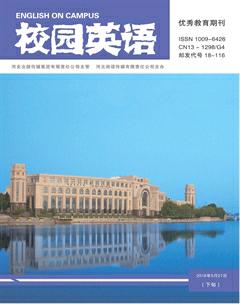The Application of Hedges in EFL Class
闫志军
【Abstract】Hedges, as a common linguistic phenomenon, are used in daily communication to make sure that the communication can move on smoothly and to attain specific goals by speakers. If the hedges are used properly in class, they could make talks between teacher and students become more polite, flexible and effective and facilitate effective teaching and learning. Based on the writers past experience, this paper intends to analyze the specific application and pragmatic functions of hedges used by both teacher and students in EFL class.
【Key words】hedges; EFL class; pragmatic functions; application
1. Introduction
Hedges, as an important component of fuzzy language, have received wide attention of linguists in the past few decades. Lakoff, who is the first person that studies hedges from the linguistic perspective, defines hedges as “words whose job is to make things fuzzier or less fuzzy”. Researchers at home have done a lot of work on the pragmatic functions of hedges in news, technology articles, political speech and others. However, less research has been done on the pragmatic functions of hedges in EFL class. EFL class is the place where communication takes place, so the research should consider both sides of the communication. This paper will analyze the applications of hedges used by teacher and students in order to find how the hedges promote English teaching and learning and their pragmatic functions in EFL class.
2. Classification of Hedges
Hedges in English are a very wide range of words and expressions including verbs, model verbs, adjectives, nouns, if-clauses, passive voice, etc. According to the dichotomy proposed by He Ziran, whether the hedges can change the truth condition of the discourse or whether to change the original intent of the discourse structure, hedges can be divided into two parts: Approximators(subdivided into Adaptors and Rounders) and Shields(subdivided into Plausibility Shields and Attribution Shields).
Approximators are those that affect the truth-conditions of propositions. They may change or even cancel the original meaning of proposition. Approximators can be subdivided into two types: Adaptors and Rounders. Adaptors are usually used when a proposition is nearly precise but the speakers or writers are not absolutely certain (He Ziran, 1985), such as: always, usually, quite, kind of, sort of, to some extent, a little bit, etc. Shields are those that do not affect the truth-conditions but reflect the degree of the speakers commitment to the truth-value of the whole proposition. (He Ziran, 1985) Shields can also be subdivided into two types: Plausibility shields and Attribution shields.endprint
3. Adaptors used by Teacher
Teacher in EFL class usually use Adaptors to change his intensity of tone in order to make his talk more euphemistic or polite, save the students face. Adaptors can also help teacher to make the sentences of which he is not certain more appropriately. Lets see some examples:
Example 1: T: To some extent, your answer is right.
In Example 1, the teacher uses the adaptor “to some extent” to give evaluation of answer made by some student who actually fails to give the correct answer the teacher wants. In doing so, teacher can save the students face and protect the students enthusiasm of answering questions.
4. Hedges Used by Students in EFL Class
EFL class is composed of teacher and students, so the characteristics of students talk should not be ignored. But most of the current English class is still teacher-centered, students talk mainly involve in answering the teachers questions or the dialogues between students themselves. So students use much fewer hedges than the teacher and most of the hedges used by students are plausibility shields. They can use these hedges to answer the teachers questions or express their views. For example:
Example 2: I think this sentence should use past perfect tense.
With the help of plausibility shields, students can express their views more freely and get more opportunities to talk which is benefit for the improvement of their communicative competence.
5. Conclusion
Both teacher and students use hedges in EFL class and the hedges play a positive role in the communication between teacher and students. The limitation of this paper lies that the analysis of the hedges used by teacher and students is confined to imaginations and the authors past experience, so that the correctness and authority of this paper are weakened. Further study of this paper may collect data from actual classes to test what kind of hedges is the most frequently used by teacher and students, and find out the representative situations where teacher and students use hedges.
References:
[1]George Yule.Pragmatics[M].Shanghai:Foreign Language Education Press,2000.
[2]何自然.模糊限制语与言语交际[J].外国语,1985,(5).
[3]伍铁平.模糊语言学初探[J].外国语,1979,(4).
[4]伍铁平.模糊语言学再探[J].外国语,1980,(4).endprint

